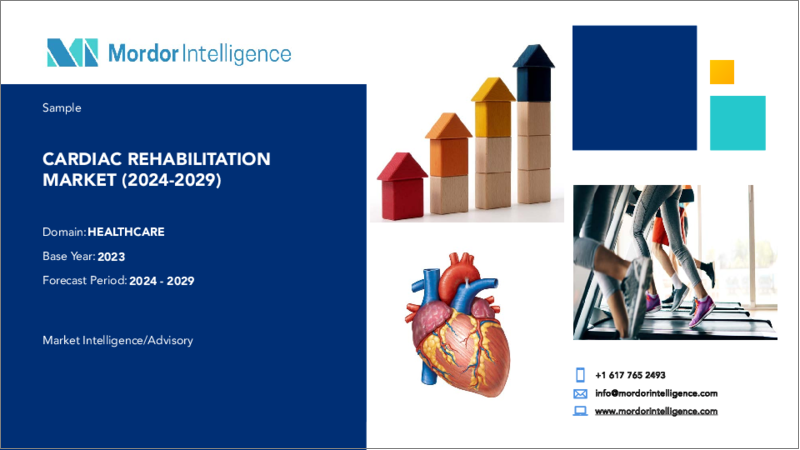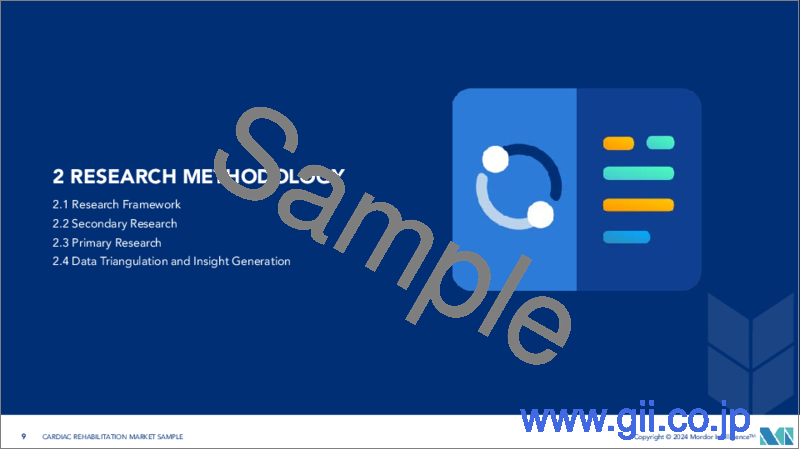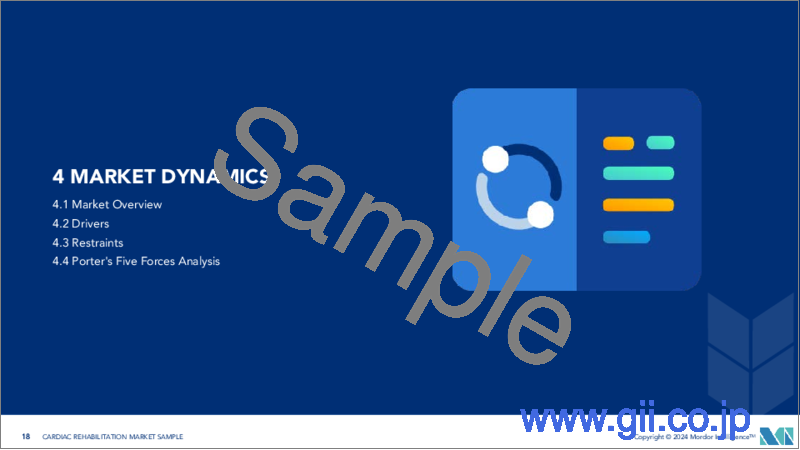|
|
市場調査レポート
商品コード
1405374
心臓リハビリテーション:市場シェア分析、産業動向と統計、2024~2029年の成長予測Cardiac Rehabilitation - Market Share Analysis, Industry Trends & Statistics, Growth Forecasts 2024 - 2029 |
||||||
カスタマイズ可能
適宜更新あり
|
|||||||
| 心臓リハビリテーション:市場シェア分析、産業動向と統計、2024~2029年の成長予測 |
|
出版日: 2024年01月04日
発行: Mordor Intelligence
ページ情報: 英文 113 Pages
納期: 2~3営業日
|
全表示
- 概要
- 目次
心臓リハビリテーション市場規模は2024年に23億1,000万米ドルと推計され、2029年には29億6,000万米ドルに達し、市場推計・予測期間中(2024-2029年)にCAGR 6%で成長すると予測されています。
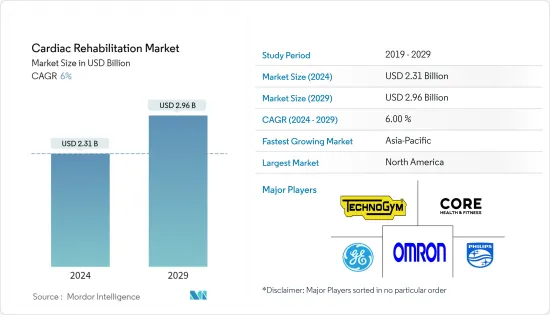
COVID-19パンデミックの特異的な特徴から、心臓病患者が心臓リハビリテーションやセンターベースの運動プログラムに安全に参加できるかどうか、またその方法を特定することは困難でした。2022年8月にEuropean Journal of Preventive Cardiologyが発表した研究によると、パンデミックはCOVID-19疾患の重症患者群に対するリハビリテーションの需要を高めていました。さらに、植え込み型心臓リハビリテーション製品を用いた遠隔患者モニタリングは、対面のみの訪問に代わる安全な方法であり、患者満足度の向上と臨床転帰の改善につながった。例えば、2021年2月、RhythMedix社は、不整脈検出用の4G携帯電話接続機能を内蔵した次世代心臓モニターRhythmStarを発売しました。そのため、COVID-19の大流行により市場に有益な影響を与えると予想される心臓リハビリテーションのニーズが高まっていました。しかし、COVID-19症例の減少や医療アクセス強化によるヘルスケア分野の回復により、市場はパンデミック前の状態に戻りつつあります。予測期間中、市場は安定した上昇を続けると思われます。
心臓リハビリテーション市場は、主に世界中で心臓病を減らす取り組みが増加していることと、先進国で健康とフィットネスに対する一般国民の関心が高まっていることが要因となっています。例えば、WHOが2022年9月に発表した論文では、東南アジア地域の主要な死因であり、毎年360万人の命が失われている心血管疾患による死亡率を削減するための一致団結した取り組みが呼びかけられています。WHO東南アジア地域は、「WHO東南アジアHEARTSイニシアチブ」であるSEA HEARTSを通じて、2030年までに心血管疾患(CVDs)による死亡率を3分の1に減少させるため、現在進行中の活動を拡大・統合する意向です。
さらに、上記の情報源によれば、加盟各国、パートナー、学術機関、市民社会組織の代表者がSEA HEARTSのウェビナーに参加し、心血管の健康を促進するための協調的な努力の一環として、CVDに対する行動を加速するための戦略を検討しました。このような取り組みにより、心臓病が減少し、心臓リハビリテーションの需要が増加することが期待されます。
さらに、心臓リハビリテーションの需要のため、市場プレイヤーは製品開拓や新規の発売にも力を入れています。例えば、2022年3月、MFineはアプリ上で心拍数モニタリング(HR)ツールを開始し、ユーザーは追加のデバイスや他のアプリを必要とせずに心拍数を記録できるようになりました。したがって、上記の要因から、心臓リハビリテーション市場は予測期間中に成長すると予想されます。しかし、発展途上国市場や低開発国における知識不足が、予測期間中の市場成長を阻害すると予想されます。
心臓リハビリテーション市場の動向
心臓リハビリテーション市場ではトレッドミルセグメントが大きな市場シェアを占める見込み
トレッドミルは体を健康に保つための最もポピュラーなアクティビティの一つであり、頻繁に利用されています。心不全の既往歴のある人には強く勧められます。心臓リハビリ中のトレッドミルの主な機能は目標心拍数の選択です。患者には通常、運動中に達成すべき心拍数の目標が与えられます。トレッドミル運動は心臓と体全体を鍛えるので、心臓病患者にとって最良のリハビリのひとつであることが観察されています。
例えば、2022年1月にJournal of Clinical Medicine誌に発表された研究によると、トレッドミル運動療法が末梢動脈疾患(PAD)患者の機能的能力とQOLに及ぼす影響は良好でした。トレッドミル運動療法を受けたPAD患者は心肺機能、トレッドミル歩行能力、死亡率が改善されます。
主要な市場プレーヤーによる製品発売は、森林期間中の市場成長をサポートします。例えば、2021年8月、Peloton Interactive(PTON.O)は米国で安全機能を備えた新しいトレッドミルを発売しました。トレッドミルには、ワークアウト前にベルトのロックを解除するためのデジタルパスコードや、ランナーが素早く停止するための物理的な安全キーなどの安全機能が搭載されています。
従って、上記の要因は予測期間中にセグメントの成長を押し上げると予想されます。
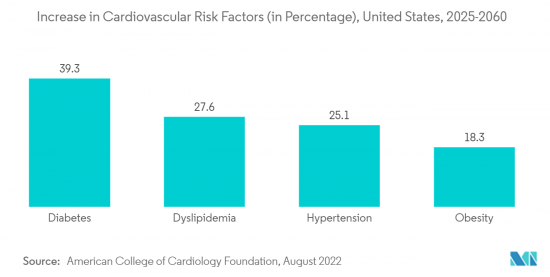
北米が市場で大きなシェアを占めると予想され、予測期間中も同様と予想される
北米はヘルスケアの面で世界で最も発展した地域であり、その主な理由は、人々の新技術への採用率が高いことと、心臓病の負担軽減への関心が高まっていることです。この地域では心臓リハビリテーションの需要が高まっており、調査対象市場の成長に寄与しています。
例えば、2022年8月には、5年間で100万人の心臓発作と脳卒中を予防するために、CDCとメディケア&メディケイドサービスセンターが共同で主導する国家イニシアチブ「Million Hearts」が実施されました。このイニシアチブは、心臓病、脳卒中、およびその関連疾患への影響を考慮して選択された少数の優先事項に関するパートナーの行動に焦点を当てたものです。このイニシアチブの目標には、対象となる患者の心臓リハビリテーションへの70%の参加と、運動不足の20%削減が含まれていました。
同様に、カナダ政府は心臓病に対処し、死亡率を減らすための数多くのプログラムに重点を置いた。例えば、2022年8月、カナダ政府は3つの団体に170万米ドル以上を提供し、カナダ全土の低所得地域や学校コミュニティだけでなく、高齢者の身体活動を改善することを目的としたイニシアチブに資金を提供しました。このように、身体活動と心臓リハビリテーションへの注目の高まりは、同地域の市場を押し上げると予想されます。
さらに、さまざまな市場プレーヤーが、合併買収、資金調達、製品イントロダクションなど、いくつかの戦略を用いています。例えば、2022年3月、遠隔医療によるバーチャル心臓治療を提供するRecora社は、2,000万米ドルの投資ラウンドを報告しました。さらに、同社の心臓リハビリテーション・プログラムは、全国の臨床医や医療プランが利用できるようになりました。
したがって、上記のすべての要因は、北米地域における予測期間中の市場成長を促進すると予想されます。
心臓リハビリテーション業界の概要
心臓リハビリテーション市場は、世界的および地域的に事業を展開する企業が存在するため、その性質上、適度に集中しています。市場に参入している企業には、GEヘルスケア、Koninklijke Philips N.V.、オムロン株式会社、Core Health &Fitness, LLC、Technogymなどがあります。
その他の特典
- エクセル形式の市場予測(ME)シート
- 3ヶ月間のアナリスト・サポート
目次
第1章 イントロダクション
- 調査の前提条件と市場定義
- 調査範囲
第2章 調査手法
第3章 エグゼクティブサマリー
第4章 市場力学
- 市場概要
- 市場促進要因
- 世界の心臓病減少への取り組みの高まり
- 先進諸国における健康志向の高まり
- 市場抑制要因
- 発展途上国や低開発国における知識不足
- ポーターのファイブフォース分析
- 新規参入業者の脅威
- 買い手/消費者の交渉力
- 供給企業の交渉力
- 代替品の脅威
- 競争企業間の敵対関係の強さ
第5章 市場セグメンテーション(市場規模)
- 製品タイプ別
- トレッドミル
- エリプティカル・トレーナー
- スタビライゼーション・ボール
- ローワー
- 血圧モニター
- 心拍数モニター
- その他の製品タイプ
- 地域
- 北米
- 米国
- カナダ
- メキシコ
- 欧州
- ドイツ
- 英国
- フランス
- イタリア
- スペイン
- その他欧州
- アジア太平洋
- 中国
- 日本
- インド
- オーストラリア
- 韓国
- その他アジア太平洋地域
- 中東・アフリカ
- GCC
- 南アフリカ
- その他中東とアフリカ
- 南米
- ブラジル
- アルゼンチン
- その他南米
- 北米
第6章 競合情勢
- 企業プロファイル
- Ball Dynamics International, LLC
- Core Health & Fitness, LLC
- Honeywell International, Inc.
- Omron Corporation
- Koninklijke Philips N.V.(BioTelemetry Inc)
- ICU Medical(Smiths Group)
- Halma plc
- Anta Sport(Amer Sports)
- GE Healthcare
- Technogym
- Baxter Medical
第7章 市場機会と今後の動向

The Cardiac Rehabilitation Market size is estimated at USD 2.31 billion in 2024, and is expected to reach USD 2.96 billion by 2029, growing at a CAGR of 6% during the forecast period (2024-2029).
The specific characteristics of the COVID-19 pandemic made it challenging to identify whether and how people with heart disease could participate safely in cardiac rehabilitation and center-based exercise programs. According to the study published by the European Journal of Preventive Cardiology in August 2022, the pandemic had increased the demand for rehabilitation for COVID-19 patient groups who were critically ill with COVID-19 disease. Additionally, remote patient monitoring using implantable cardiac rehabilitation products was a safe alternative to in-person-only visits, which led to enhanced patient satisfaction and improved clinical outcomes. For instance, in February 2021, RhythMedix launched the next-generation cardiac monitor RhythmStar with built-in 4G cellular connectivity for arrhythmia detection. Therefore, there had been a greater need for cardiac rehabilitation, which was anticipated to have a beneficial impact on the market due to the COVID-19 pandemic. However, the market is returning to its pre-pandemic state due to decreased COVID-19 cases and the recovery of the healthcare sector with enhanced health access. The market will continue to rise steadily over the forecast period.
The cardiac rehabilitation market is primarily driven by increasing efforts to reduce heart diseases across the globe and the rising focus of the general population on health and fitness in developed countries. For instance, an article published by WHO in September 2022 called for a united effort to reduce mortality from cardiovascular diseases, a leading cause of death in the Southeast Asia Region, with 3.6 million lives lost every year. Through SEA HEARTS, the "WHO Southeast Asia HEARTS initiative," the WHO Southeast Asia Region intends to scale up and integrate ongoing activities in order to reduce mortality from cardiovascular diseases (CVDs) by one-third by 2030.
Additionally, according to the above source, representatives from Member countries, partners, academic institutions, and civil society organizations took part in the SEA HEARTS webinar, which examined strategies to speed up action against CVDs as part of a coordinated effort to promote cardiovascular health. Thus, such efforts are expected to reduce heart disease, leading to an increased demand for cardiac rehabilitation.
Furthermore, due to the demand for cardiac rehabilitation, market players are also focusing on product development and novel launches. For instance, in March 2022, MFine launched a Heart Rate Monitoring (HR) Tool on its app, which enables users to keep track of their heart rate without needing an additional device or any other app. Hence, as per the factors mentioned above, the cardiac rehabilitation market is anticipated to grow over the forecast period. However, a lack of knowledge in developing or underdeveloped nations is expected to impede market growth over the forecast period.
Cardiac Rehabilitation Market Trends
Treadmill Segment is Expected to Hold a Significant Market Share in the Cardiac Rehabilitation Market
The treadmill is one of the most popular activities to keep the body healthy and is frequently utilized. It is strongly advised for people with a history of heart failure. The treadmill's main function during cardiac rehab is choosing a target heart rate. Patients are usually given a heart rate goal to achieve during their exercise. It has been observed that treadmill exercise is one of the best rehabs for cardiac patients as it works out the heart and the overall body.
For instance, according to the study published in the Journal of Clinical Medicine in January 2022, the effects of supervised treadmill exercise therapy on peripheral artery disease (PAD) patients' functional capacity and quality of life are favorable. Patients with PAD who get supervised treadmill exercise therapy have improved cardiorespiratory fitness, treadmill walking performance, and a lower mortality rate.
Product launches by the key market players support the market growth over the forest period. For instance, in August 2021, Peloton Interactive (PTON.O) launched its new treadmill with safety features in the United States. Treadmills have safety features, including a digital passcode to unlock the belt before a workout and a physical safety key that can help a runner come to a quick stop.
Thus, the above-mentioned factor is expected to boost the segment growth over the forecast period.

North America is Expected to Hold a Significant Share in the Market and Expected to do Same in the Forecast Period
North America is the most developed region in the world in terms of healthcare, primarily attributed to the higher adoption of the population to novel technologies and increasing focus on reducing the burden of heart disease. There is a growing demand for cardiac rehabilitation in the region, contributing to the growth of the market studied.
For instance, in August 2022, the Million Hearts, a national initiative, was co-led by the CDC and the Centers for Medicare & Medicaid Services to prevent 1 million heart attacks and strokes in 5 years. The initiative focused on partner actions on a small set of priorities selected for their impact on heart disease, stroke, and related conditions. The goals of the initiative included 70% participation in cardiac rehabilitation among eligible patients, along with a 20% reduction in physical inactivity.
Similarly, the Canadian Government focused on numerous programs to cope with heart disease and reduce mortality. For instance, in August 2022, the Canadian Government provided more than USD 1.7 million to three organizations to fund initiatives aimed at improving seniors' physical activity as well as those in low-income areas and school communities across Canada. Thus, a growing focus on physical activity and cardiac rehabilitation is expected to boost the market in the region.
Furthermore, various market players use several strategies, such as merger and acquisition, fundraising, and product introduction. For instance, in March 2022, Recora, a provider of virtual cardiac healing through telehealth, reported a USD 20 million investment round. Additionally, its cardiac rehabilitation program was accessible to clinicians and health plans across the country.
Thus, all the above-mentioned factors are expected to boost the market growth over the forecast period in the North American region.
Cardiac Rehabilitation Industry Overview
The cardiac rehabilitation market is moderately concentrated in nature due to the presence of companies operating globally and regionally. The companies in the market include GE Healthcare, Koninklijke Philips N.V., Omron Corporation, Core Health & Fitness, LLC, and Technogym.
Additional Benefits:
- The market estimate (ME) sheet in Excel format
- 3 months of analyst support
TABLE OF CONTENTS
1 INTRODUCTION
- 1.1 Study Assumptions and Market Definition
- 1.2 Scope of the Study
2 RESEARCH METHODOLOGY
3 EXECUTIVE SUMMARY
4 MARKET DYNAMICS
- 4.1 Market Overview
- 4.2 Market Drivers
- 4.2.1 Increasing Efforts to Reduce the Heart Diseases Across the Globe
- 4.2.2 Rising Focus of General Population on Health and Fitness in Developed Countries
- 4.3 Market Restraints
- 4.3.1 Lack of Knowledge in the Developing or Under Developed Nations
- 4.4 Porter's Five Forces Analysis
- 4.4.1 Threat of New Entrants
- 4.4.2 Bargaining Power of Buyers/Consumers
- 4.4.3 Bargaining Power of Suppliers
- 4.4.4 Threat of Substitute Products
- 4.4.5 Intensity of Competitive Rivalry
5 MARKET SEGMENTATION (Market Size by Value USD)
- 5.1 By Product Type
- 5.1.1 Treadmill
- 5.1.2 Elliptical Trainer
- 5.1.3 Stabilization Ball
- 5.1.4 Rower
- 5.1.5 Blood Pressure Monitor
- 5.1.6 Heart Rate Monitor
- 5.1.7 Other Product Types
- 5.2 Geography
- 5.2.1 North America
- 5.2.1.1 United States
- 5.2.1.2 Canada
- 5.2.1.3 Mexico
- 5.2.2 Europe
- 5.2.2.1 Germany
- 5.2.2.2 United Kingdom
- 5.2.2.3 France
- 5.2.2.4 Italy
- 5.2.2.5 Spain
- 5.2.2.6 Rest of Europe
- 5.2.3 Asia-Pacific
- 5.2.3.1 China
- 5.2.3.2 Japan
- 5.2.3.3 India
- 5.2.3.4 Australia
- 5.2.3.5 South Korea
- 5.2.3.6 Rest of Asia-Pacific
- 5.2.4 Middle East and Africa
- 5.2.4.1 GCC
- 5.2.4.2 South Africa
- 5.2.4.3 Rest of Middle East and Africa
- 5.2.5 South America
- 5.2.5.1 Brazil
- 5.2.5.2 Argentina
- 5.2.5.3 Rest of South America
- 5.2.1 North America
6 COMPETITIVE LANDSCAPE
- 6.1 Company Profiles
- 6.1.1 Ball Dynamics International, LLC
- 6.1.2 Core Health & Fitness, LLC
- 6.1.3 Honeywell International, Inc.
- 6.1.4 Omron Corporation
- 6.1.5 Koninklijke Philips N.V. (BioTelemetry Inc)
- 6.1.6 ICU Medical (Smiths Group)
- 6.1.7 Halma plc
- 6.1.8 Anta Sport (Amer Sports)
- 6.1.9 GE Healthcare
- 6.1.10 Technogym
- 6.1.11 Baxter Medical
